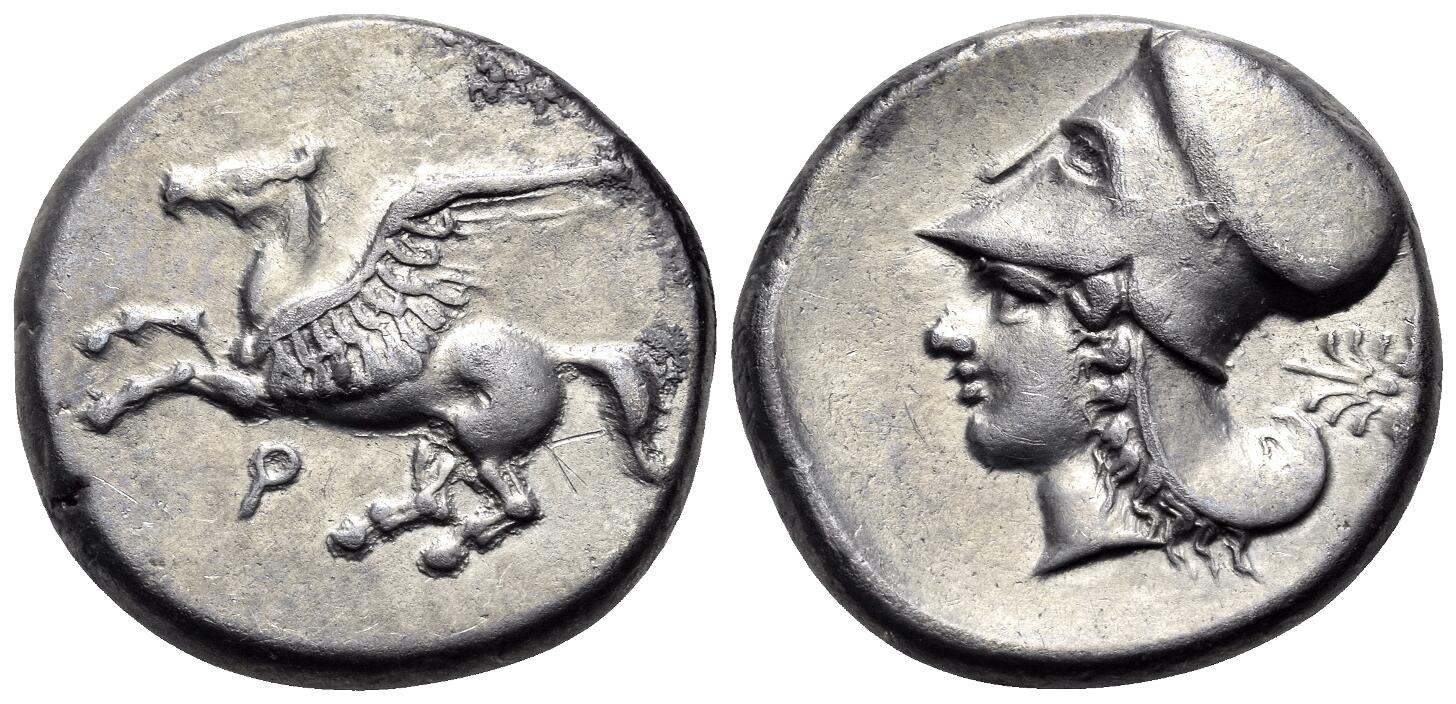400 BCE - 350 BCE | ΘΟΥΡΙΩΝ
Overstriking coin
SO 1314 - Thurium over Corinth.jpg
Overstruck variety
Traces of the overstruck variety
1314 Corinth (drawing).jpg
Description
| ObverseInscription or printing placed on the obverse.:
|
Head of Athena right, wearing crested Attic helmet decorated with Skylla.
|
ReverseInscription or printing placed on the reverse.:
|
ΘΟΥΡΙΩΝ (Greek) Bull charging right. Above, NY. In exergue, fish.
|
Mint and issuing power
| MintIdentifies the place of manufacture or issue of a numismatic object.:
|
Thurium
|
Ancient regionAncient region.
|
Lucania
|
Modern countryModern country: Italy
|
AuthorityIdentifies the issuing power. The authority can be "pretended" when the name or the portrait of X is on the coin but he/she was not the issuing power. It can also be "uncertain" when there is no mention of X on the coin but he/she was the issuing power according to the historical sources:
|
|
Chronology
| FromIdentifies the initial date in a range assigned in a numismatic context. 400 BCE toIdentifies the final date in a range assigned in a numismatic context.. 350 BCE
|
Classical 480-323 BC  periodTime period of the numismatic object. periodTime period of the numismatic object.
|
Physical description
MetalThe physical material (usually metal) from which an object is made.: Silver 
|
WeightWeight of the numismatic object (in grams). in grams: 7.757.75 g <br />7,750 mg <br />
|
DenominationTerm indicating the value of a numismatic object. Examples: tetradrachm, chalkous, denarius.: nomos
|
AxisDescribes the directional relationship between the obverse and reverse of a numismatic object.: 99 mm <br />0.9 cm <br />
|
|
|
StandardStandard.: Achaian
|
References
| Coin referenceReference of the Coin:
|
MacDonald 2009, p. 33-34, n° 24
|
Coin series referenceReference to coin series study:
|
MacDonald 20091MacDonald 2009, p. 33-34, n° 24, SNG ANS 2 Lucania2SNG ANS 2 Lucania, n° 1054, HN Italy3HN Italy, n° 1790 var. (fish on reverse unlisted), HGC 14HGC 1, n° 1260 or 1262
|
| Coin series web referenceCoin series web references:
|
|
Description
| ObverseInscription or printing placed on the obverse.:
|
Ϙ (Greek) Pegasus flying right (visible on obverse: head, neck, and portion of wing).
|
ReverseInscription or printing placed on the reverse.:
|
Head of Athena right, wearing Corinthian helmet. Behind, palmette (visible on reverse: back of helmet, neck guard, and most of palmette).
|
Mint and issuing power
| MintIdentifies the place of manufacture or issue of a numismatic object. ᵖ:
|
Corinth
|
Ancient regionAncient region. ᵖ
|
Peloponnesus
|
Modern countryModern country: Greece
|
AuthorityIdentifies the authority in whose name (explicitly or implicitly) a numismatic object was issued. ᵖ:
|
|
Chronology
| FromIdentifies the initial date in a range assigned in a numismatic context. 410 BCE toIdentifies the final date in a range assigned in a numismatic context.. 350 BCE
|
Classical 480-323 BC  periodTime period of the numismatic object. periodTime period of the numismatic object.
|
Physical description
| DenominationTerm indicating the value of a numismatic object. Examples: tetradrachm, chalkous, denarius. ᵖ:
|
stater 
|
|
|
References
References
- ^ Macdonald, David (2009), Overstruck Greek coins: studies in Greek chronology and monetary theory, Whitman Publishing, Atlanta.
- ^ Troxell, Hyla S. (1972), Sylloge Nummorum Graecorum: The collection of the American Numismatic Society. Part 2. Lucania, New York
- ^ Rutter N. Keith et alii (eds.) (2001), Historia Numorum Italy, London, xvi, 223 p., 43 pl.
- ^ Hoover, Oliver D. (2018), The Handbook of Greek Coinage Series, Volume 1. Handbook of Coins of Italy and Magna Graecia, Sixth to First Centuries BC., Lancaster-London, 2018, lxi, 527 pages, 23 cm
- ^ Calciati, Romolo (1990), Pegasi, Mortara, Edizioni I.P..
 Traces of the overstruck variety
Traces of the overstruck variety

